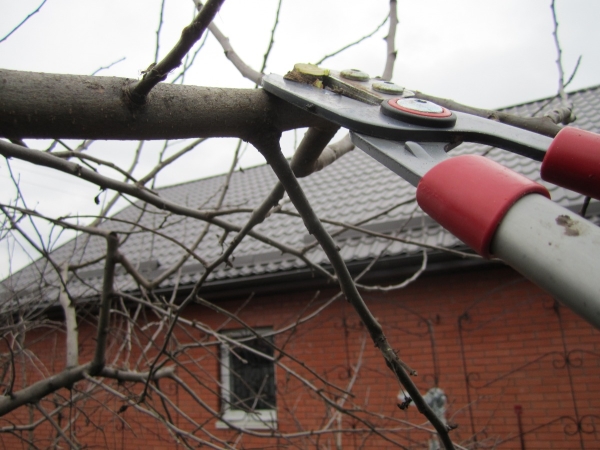Plum, like any fruit crop, needs crown formation. Kronirovanie - art is akin to architecture. From the gardener requires a developed spatial thinking, as well as knowledge of the physiology of plants.
Before approaching a tree with a pruner, you need to understand well the meaning and purpose of your actions and know the techniques of pruning.
Table of contents
Types and methods of forming the correct crown
Plum, especially young, is an extremely fast growing plant.. In one spring-summer season, it is capable of expelling such a number of shoots that it will “derail” beyond recognition.
This is not good from an aesthetic point of view. On a neglected crown, the fruits become shallow, mature longer, and are more often affected by moniliosis and pinwort. Cold resistance of the plant is reduced.
That is why plum sapling must be educated, starting with planting.
Depending on the purpose, pruning of fruit trees is of five types:
- Formative. The goal - the design of the crown of the plant.
- Regulatory. The goal is to maintain a satisfactory condition.
- Rejuvenating. The goal is to restore the fruiting of the old tree.
- Recovery. The goal - the elimination of dry and broken branches.
- Sanitary. The goal - the elimination of diseased and pest-prone shoots.
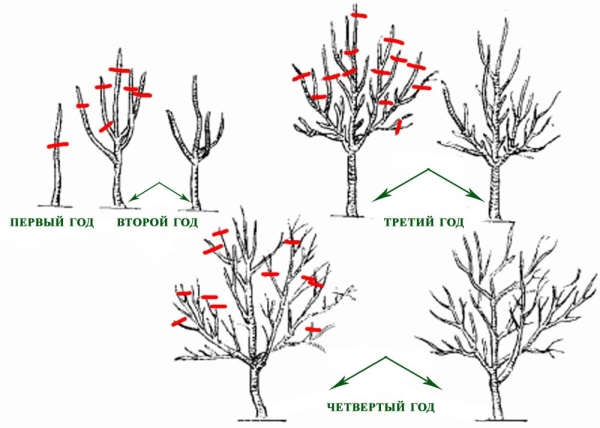
Regardless of the purpose, usually when cutting prunes, three techniques are used:
- Cut "ring". This way completely removes the unnecessary branch.At the same time it is cut off not flush with the trunk, but along the border of the annular thickening at the place of attachment of the shoot.
- Cut to the kidney. It is used when you need to shorten the escape and ask him the direction of growth. A good live kidney is selected in the desired position, and the excess part is removed by shears. It is important to do this strictly at an angle of 45⁰ so that the upper edge of the slice is in line with the top of the kidney.
- Transfer to the side escape. This is a technique for a cardinal change in the direction of growth and rejection of unproductive branches. For this, the most promising are selected from the side shoots and cut 2-3 mm above the point of its attachment (“ring”).
For successful work you need the right set of tools. In the mandatory list: pruner, pruner, two garden saws (large and small), a good garden knife, stepladder and garden pitch.
Plum crown formation:
At what time you can prune the plum in the spring and autumn, the timing
Having dealt with the theoretical fundamentals of kronirovaniya, you can pick the right time for pruning.
Most often, these procedures are carried out spring and autumn. The specific type of work and some nuances will depend on the age and condition of the tree.
| Spring | |
| The ideal time for active interaction with trees is the beginning of spring. During this period, the plants are more easily tolerated by “surgical interventions,” and receive an incentive to bookmark flower buds. The exact timing of spring pruning depends on the region. Need to navigate the weather and the development of the kidneys. The best moment when the frosts have already receded, but the kidneys have not yet begun to swell. |
|
| Types of jobs | Young plum | Old plum |
|
|
| Autumn | |
| Autumn pruning pruned do in September or early October, depending on the region.The exact time is determined by its own tree: as soon as the plum has dropped the leaves, you can work with it. | |
| Types of jobs | Young plum | Old plum |
|
|
You can not do sanitary and other types of circumcision with the same tool. After the removal of diseased branches it is necessary wash with a solution of fungicide or alcohol. Then wipe thoroughly with a clean rag.
To cut or not to cut branches in the fall?
Among gardeners there is no consensus about the feasibility of autumn manipulations with a hacksaw. On forums you can meet, for example, such reviews:
“Before the winter, my grandfather cut in the garden all trees except plum. As I understand, pruning a plum in the fall increases the likelihood of its freezing. ”
"If there are severe frosts in winter, the cut plant can get frostbite and necrosis of this area."
Really, in the autumn you need to be very careful about the life of the tree. Autumn cuts and cuts heal poorly. This is due to the physiology of the plant.
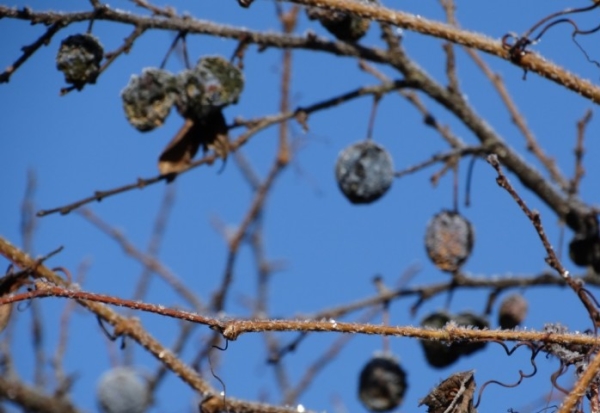
The healing of wounds in a tree is due to the growth of the cambium. The cambial cells actively divide, forming an influx around the wound - callus. The growth of cambium occurs in spring and summer, and gradually stops in autumn.
If not guess the time and trim the plum late, the risk of infection increases significantly and draining the wound surface. The plant goes into the winter weakened and does not tolerate frosts.
Therefore, if some procedure can be postponed until spring, it is better to leave your plum alone. Mandatory manipulation is only sanitary pruning of a diseased tree and the elimination of broken branches.
How is pruning in other seasons: summer and winter
Some fruit crops in the summer is better not to touch the shears once again. Plum, on the contrary, is favorable to summer pruning. "Haircut" is better to plan for June.
You can do the following at this time:
- remove the frozen shoots unnoticed in spring;
- remove fat shoots (the so-called "wolf"), who likes to drive out the plum.
We offer you the following publications:
Thus, two goals are achieved: the spread of the disease in the garden is stopped, and the need for extensive sanitary pruning in the fall is reduced.
In recent years, garden practice is becoming more and more active. winter pruning pruning. It is more correct, of course, to call it winter-spring, because this procedure is carried out towards the end of February or at the very beginning of March.
The spread of winter pruning is due to the general instability of the climate, to which the plum tree may react to early awakening.
In winter they spend all the usual spring types of pruning.. This period has its plus: as long as the cambium does not start growing, the bark is more densely attached to the wood, and you should not be afraid to bend and tear it.
Winter pruning pruning is carried out only in regions with mild winters. It is impossible to injure a tree if there is a risk of returning frost.
Spring pruning plum and cherry plum:
Receptions and trimming schemes
To book a plum properly, need to imagine what a well-groomed plum tree looks like. If the variety is not kolonovidny, it will be a neat tree, with one central conductor and 4-5 skeletal branches arranged in tiers.
The diameters of the tiers are reduced - the lower ones are larger than the upper ones. Skeletal branches do not move away from the trunk at an acute angle. The crown is not thickened, shoots grow on the outside, not inward.
Having built in your mind the “project” of the future tree, you can begin to shape it.
Post-plant circumcision of young plums
One-year-old plum "babies" still do not branchtherefore, it’s better to start raising your tree from this age. You just need to determine the growth of the future plum and cut the stem at the desired height.
For a compact tree, it will be enough to leave 1-1.2 meters above the ground.
Two-year-olds already have side shoots. You need to inspect the seedling, check whether the center conductor is cut off. If not, it is shortened to the optimum height.
Then from the remaining side gains choose the most developed. They are shortened by 25-30 cm from the trunk. These are skeletal branches, the future frame of the crown.. The cut is made on the lower kidney, so that the branch develops not upwards, but laterally.
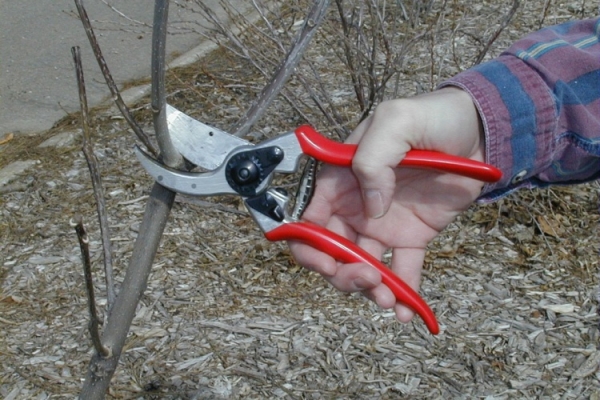
Forming from the age of 3
On a three-year tree, skeletal shoots already well branched. You need to work with them like this:
- Trim growths cut to a length of 30 cm.
- Side - up to a length of 15 cm.
All sections are again made on the lower kidney.. The goal - to set the direction of growth of shoots out. In this case, the crown will be light, not thickened, each branch will receive a sufficient amount of sunlight.
This form is one of the most convenient. Caring for a tree so formed is uncomplicated. In the future, he will need only regulatory pruning. This type of work should be carried out annually so that the tree does not grow.
If you care for the formed plum constantly, you will have to use the file only in emergency cases. Basically, it will be possible to manage with a simple embossing with shears.
Any cut is an open wound on the body of the tree.. It must be sealed with a garden pitch. It protects the plant from drying out, infection and gum treatment.
Pruning young plums:
To rejuvenate old wood
Most plums bring about 15-20 years of harvest.. Prolong fruiting, rejuvenate the plum can be, if in time to make a rejuvenating pruning tree.
This is done from the top down according to this scheme:
- Crown height decreases. To do this, the upper skeletal branches are cut to the desired length and transferred to good lateral shoots growing outwards. In a particularly neglected case, you can cut the uppermost skeleton branch "on the ring" to unload the center and lighten the crown.
- Removal of thickening shoots. These are all directed towards the center of the crown, or woven together. At the same time dry, weak and damaged branches are removed.
- Remove hanging shootscoming from the trunk or branches of the lower tier.
- Shortening of skeletal branches, transfer of growth to good lateral shoots directed outwards.
- Removing unnecessary "tops".
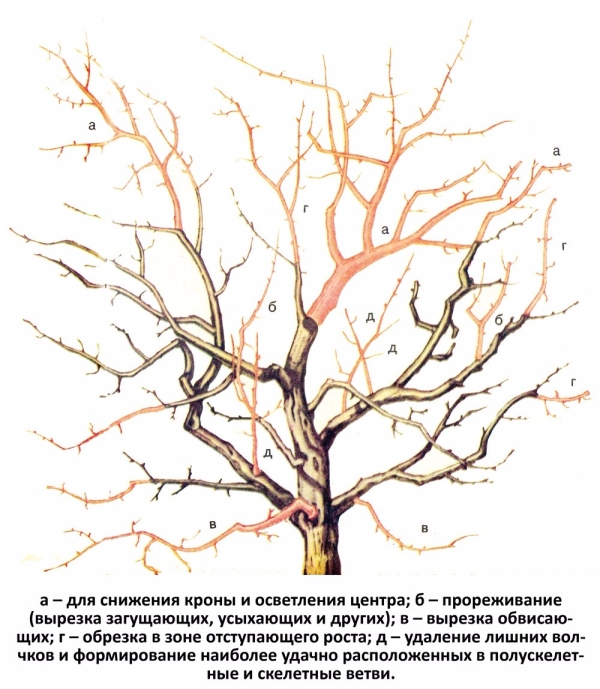
Plum very hard to heal wounds with a diameter greater than 5 cm. Therefore, you should not make several large cuts at a time. It is better to break the rejuvenating procedure into several “sessions” with an interval of one year.
As a bonus, he will receive not only decent yields and a healthy garden, but also additional space on the site. Well-kept plum takes up much less space.than growing unsupervised, and brings aesthetic pleasure.
